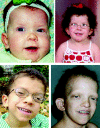The cardiofaciocutaneous syndrome
- PMID: 16825433
- PMCID: PMC2563180
- DOI: 10.1136/jmg.2006.042796
The cardiofaciocutaneous syndrome
Abstract
The cardiofaciocutaneous (CFC) syndrome is a condition of sporadic occurrence, with patients showing multiple congenital anomalies and mental retardation. It is characterised by failure to thrive, relative macrocephaly, a distinctive face with prominent forehead, bitemporal constriction, absence of eyebrows, hypertelorism, downward-slanting palpebral fissures often with epicanthic folds, depressed nasal root and a bulbous tip of the nose. The cutaneous involvement consists of dry, hyperkeratotic, scaly skin, sparse and curly hair, and cavernous haemangiomata. Most patients have a congenital heart defect, most commonly pulmonic stenosis and hypertrophic cardiomyopathy. The developmental delay usually is moderate to severe. The syndrome is caused by gain-of-function mutations in four different genes BRAF, KRAS, mitogen-activated protein/extracellular signal-regulated kinase MEK1 and MEK2, all belonging to the same RAS-extracellular signal-regulated kinase (ERK) pathway that regulates cell differentiation, proliferation and apoptosis. The CFC syndrome is a member of a family of syndromes that includes the Noonan and Costello syndromes, presenting with phenotypic similarities. Noonan syndrome is caused by mutations in the protein tyrosine phosphatase SHP-2 gene (PTPN11), with a few people having a mutation in KRAS. Costello syndrome is caused by mutations in HRAS. The protein products of these genes also belong to the RAS-ERK pathway. Thus, the clinical overlap of these three conditions, which often poses a problem of differential diagnosis, is explained by their pathogenetic relatedness.
Conflict of interest statement
Competing interests: None declared.
Similar articles
-
Cardio-facio-cutaneous and Noonan syndromes due to mutations in the RAS/MAPK signalling pathway: genotype-phenotype relationships and overlap with Costello syndrome.J Med Genet. 2007 Dec;44(12):763-71. doi: 10.1136/jmg.2007.050450. Epub 2007 Aug 17. J Med Genet. 2007. PMID: 17704260 Free PMC article.
-
Further delineation of the phenotype resulting from BRAF or MEK1 germline mutations helps differentiate cardio-facio-cutaneous syndrome from Costello syndrome.Am J Med Genet A. 2007 Jul 1;143A(13):1472-80. doi: 10.1002/ajmg.a.31815. Am J Med Genet A. 2007. PMID: 17551924
-
Cutaneous manifestations in the cardiofaciocutaneous syndrome, a variant of the classical Noonan syndrome. Report of a case and review of the literature.J Eur Acad Dermatol Venereol. 2004 May;18(3):324-7. doi: 10.1111/j.1468-3083.2004.00365.x. J Eur Acad Dermatol Venereol. 2004. PMID: 15096145 Review.
-
Absence of PTPN11 mutations in 28 cases of cardiofaciocutaneous (CFC) syndrome.Hum Genet. 2002 Oct;111(4-5):421-7. doi: 10.1007/s00439-002-0803-6. Epub 2002 Aug 24. Hum Genet. 2002. PMID: 12384786 Review.
-
Leukemia in Cardio-facio-cutaneous (CFC) syndrome: a patient with a germline mutation in BRAF proto-oncogene.J Pediatr Hematol Oncol. 2007 May;29(5):287-90. doi: 10.1097/MPH.0b013e3180547136. J Pediatr Hematol Oncol. 2007. PMID: 17483702
Cited by
-
Fibroblast growth factor signaling in mammalian tooth development.Odontology. 2014 Jan;102(1):1-13. doi: 10.1007/s10266-013-0142-1. Epub 2013 Dec 17. Odontology. 2014. PMID: 24343791 Free PMC article. Review.
-
Germline BRAF mutations in Noonan, LEOPARD, and cardiofaciocutaneous syndromes: molecular diversity and associated phenotypic spectrum.Hum Mutat. 2009 Apr;30(4):695-702. doi: 10.1002/humu.20955. Hum Mutat. 2009. PMID: 19206169 Free PMC article.
-
Epilepsy and BRAF Mutations: Phenotypes, Natural History and Genotype-Phenotype Correlations.Genes (Basel). 2021 Aug 26;12(9):1316. doi: 10.3390/genes12091316. Genes (Basel). 2021. PMID: 34573299 Free PMC article.
-
Human Engineered Cardiac Tissues Created Using Induced Pluripotent Stem Cells Reveal Functional Characteristics of BRAF-Mediated Hypertrophic Cardiomyopathy.PLoS One. 2016 Jan 19;11(1):e0146697. doi: 10.1371/journal.pone.0146697. eCollection 2016. PLoS One. 2016. PMID: 26784941 Free PMC article.
-
Cardio-facio-cutaneous and Noonan syndromes due to mutations in the RAS/MAPK signalling pathway: genotype-phenotype relationships and overlap with Costello syndrome.J Med Genet. 2007 Dec;44(12):763-71. doi: 10.1136/jmg.2007.050450. Epub 2007 Aug 17. J Med Genet. 2007. PMID: 17704260 Free PMC article.
References
-
- Reynolds J F, Neri G, Herrmann J P, Blumberg B, Coldwell J G, Miles P V, Opitz J M. New multiple congenital anomalies/mental retardation syndrome with cardio‐facio‐cutaneous involvement—the CFC syndrome. Am J Med Genet 198628413–427. - PubMed
-
- Weiss G, Confino Y, Shemer A, Trau H. Cutaneous manifestations in the cardiofaciocutaneous syndrome, a variant of the classical Noonan syndrome. Report of a case and review of the literature. J Eur Acad Derm Vener 200418324–327. - PubMed
-
- Fryer A E, Holt P J, Hughes H E. The cardio‐facio‐cutaneous syndrome and Noonan syndrome: are they the same? Am J Med Genet 199138548–551. - PubMed
-
- Neri G, Zollino M, Reynolds J F. The Noonan‐CFC controversy. Am J Med Genet 199139367–370. - PubMed
-
- Ward K A, Moss C, McKeown C. The cardio‐facio‐cutaneous syndrome: a manifestation of the Noonan syndrome? Br J Dermatol 1994131270–274. - PubMed
Publication types
MeSH terms
LinkOut - more resources
Full Text Sources
Medical
Research Materials
Miscellaneous



